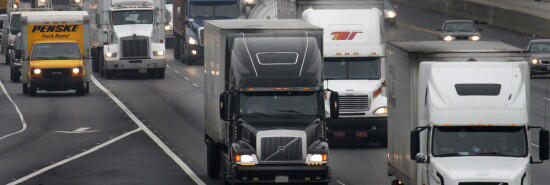
California’s push to replace its diesel fleet sparks concern and criticism from industry
Story by Breanne Deppisch
California regulators approved a contentious amendment to phase out its medium- and heavy-duty diesel trucking fleet at its ports and rail yards by 2035, an effort to wean the state off fossil fuel-powered vehicles and spur investments in electric trucks — even as industry officials have criticized the timeline as deeply impractical.
The proposed rule, passed last week by the California Air Resources Board, calls for the gradual conversion of the state’s oldest and highest-polluting off-road diesel vehicles to zero-emissions vehicles beginning in 2024.
Starting that year, all new box trucks, delivery vans, and freight trucks must be zero-emission vehicles.
And beginning in 2025, the regulations call for a gradual phase-out of all diesel-powered trucks at ports, rail yards, and warehouses across the state.
The rule, expected to be brought up for another vote in the spring, is part of California’s broader strategy to end its reliance on fossil fuels. California already has a rule in place requiring all new vehicles in the state to be either electric or plug-in electric models by 2035.
Those familiar with the proposed amendment have described it as an enforcement mechanism designed to complement the existing emissions rule and ensure the state’s fleet of aging, high-polluting trucks is actually replaced with electric models.
Currently, off-road diesel vehicles comprise roughly 14% of total nitrous oxide emissions in California, making them the second-largest source of mobile NoX in the state.
In total, regulators said the proposed rule is expected to yield $5.7 billion in public health benefits and prevent more than 570 air-quality-related deaths.
“The oldest off-road diesel-fueled vehicles with no emission controls are 80 times as polluting as a similar sized off-road vehicle purchased today,” CARB Chairwoman Liane Randolph said in a statement.
But opponents say the timeline under consideration is impractical, citing both the lack of infrastructure for heavy-duty EV chargers in California, as well as the high costs associated with making the switch.
Just 500 of the 1.8 million heavy-duty trucks operating in California today are zero emissions, Chris Shimoda, the senior vice president of government affairs at the California Trucking Association, CTA, said during a recent radio interview on California’s State of the Bay — making clear just how expansive the proposed overhaul would be.
The lack of charging infrastructure for the vehicles is another major hurdle, industry officials say.
California estimates it will need 157,000 chargers installed in the state by 2030 to support the electrification of its medium- and heavy-duty vehicle fleet.
That means that the state would need to install between 300 and 800 chargers per week until then, Shimoda said, with each representing up to 158 MW of new charging capacity — or enough to power around 100,000 households.
“Nearly none of that infrastructure is in place today,” he said.
Currently, the state has roughly 80,000 electric-vehicle chargers installed. Nearly all are designed to charge cars and light-duty vehicles.
Todd Spencer, president of the Owner-Operator Independent Drivers Association, told CalMatters that the current charging times and infrastructure could cause “total disruption” of the industry.
“Neither the technology nor the interstate infrastructure will be available in the foreseeable future to support a zero-emission requirement for long-haul interstate trucks,” he said.

In the meantime, California continues to lag badly in the production of renewable energy. When, if ever, will the media notice this?
On a per capita basis, California has developed surprisingly little green energy. Although third overall in total production behind Texas and Washington, per capita production is much smaller than that of many other US states.
For example, consider the top eight renewable energy producers. Texas produces over twice as much renewable energy per capita as does California. Washington generates over six times as much as California, Iowa in excess of eight times, Oregon over six times, and Oklahoma and Kansas more than five times. California is only slightly better than New York.
#1 Texas:
Population: 29.9 million
Renewable Energy: 33.95 GWh
Per Capita: 1,135 KWh
# 2 Washington:
Population: 7.9 million
Renewable Energy: 25.01 GWh
Per Capita: 3,166 KWh
#3 California:
Population: 40.0 million
Renewable Energy: 19.52 GWh
Per capita: 488 KWh
# 4 Iowa:
Population: 3.2 million
Renewable Energy: 13.30 GWh
Per Capita: 4,156 KWh
#5 Oregon
Population: 4.2 million
Renewable Energy: 13.11 GWh
Per Capita: 3,121 KWh
# 6 Oklahoma:
Population: 4.0 million
Renewable Energy: 10.50 GWh
Per Capita: 2,625 KWh
#7 New York:
Population: 19.8 million
Renewable Energy: 9.38 GWh
Per capita: 473 KWh
# 8 Kansas:
Population: 2.9 million
Renewable Energy: 8.27 GWh
Per Capita: 2,851 KWh
#9 Illinois:
Population: 12.7 million
Renewable Energy: 7.11 GWh
Per Capita: 560 KWh
# 10 Minnesota:
Population: 5.7 million
Renewable Energy: 5.40 GWh
Per Capita: 947 KWh